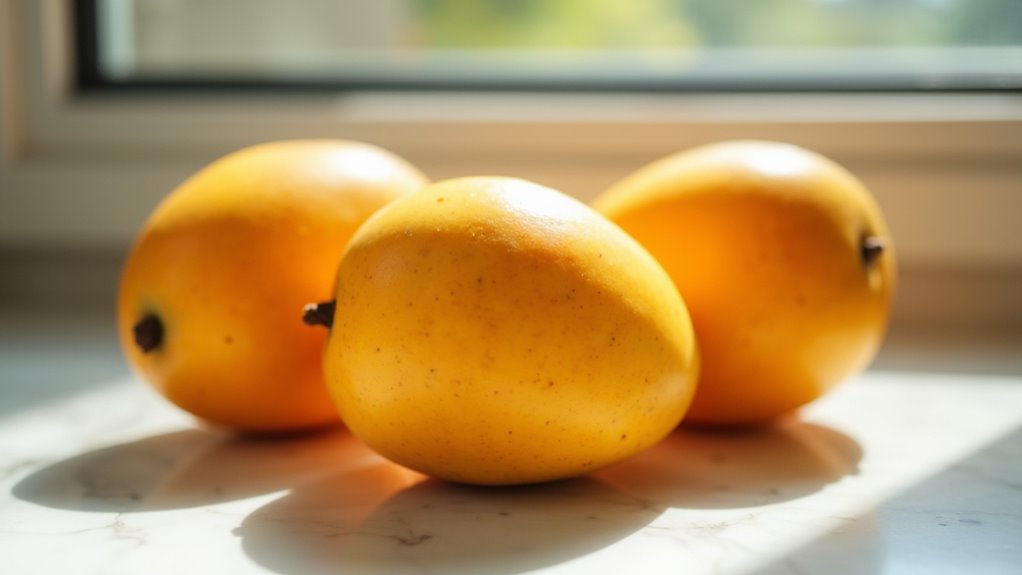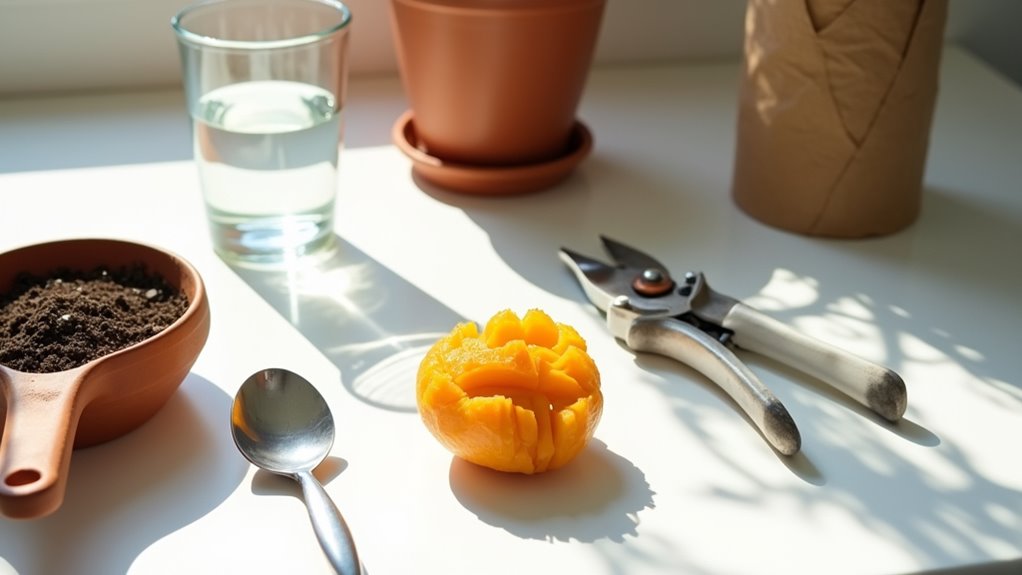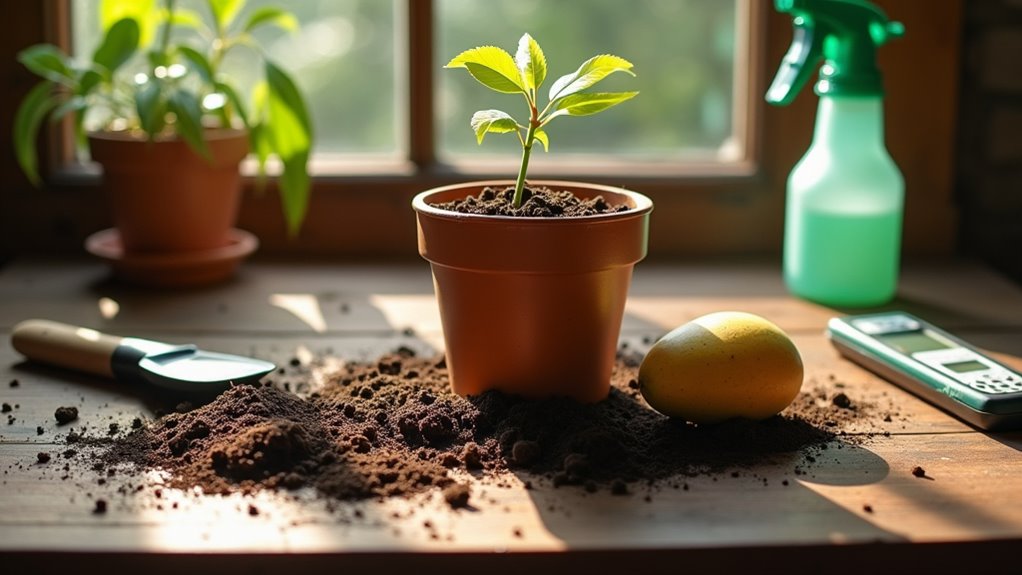Select a ripe, non-hybrid mango and carefully remove all flesh from the seed. Clean the seed under lukewarm water and dry it for 24-48 hours. Test viability by placing it in water viable seeds sink. Wrap the seed in a damp paper towel within a sealed plastic bag and maintain 70-85°F. Once sprouted, plant in well-draining soil mixed with 30% sand. Water consistently and guarantee proper airflow. Understanding the complete germination process will greatly enhance your success rate.
Selecting the Perfect Mango

When selecting a mango for seed planting, you’ll need a fully ripened fruit from a non-hybrid variety. The best mango varieties for seed propagation include Haden, Kent, and Tommy Atkins, as they’re more likely to produce trees that bear fruit similar to the parent.
Check for ripeness indicators by gently squeezing the fruit it should yield slightly to pressure. Look for a sweet, fragrant aroma near the stem end and skin that displays a mix of red, yellow, and green colors. Avoid mangoes that feel too soft or show signs of bruising.
You’ll want to choose a mango that hasn’t been exposed to prolonged refrigeration, as cold temperatures can damage the seed’s viability. The fruit should feel heavy for its size and have smooth, unblemished skin without dark spots or wrinkles.
Cleaning and Preparing the Seed
After selecting your ripe mango, you’ll need to carefully remove all flesh from the seed using a sharp knife or vegetable peeler, making sure to eliminate any stringy fibers that could promote mold growth. You should gently scrub the cleaned seed under lukewarm water to remove any remaining pulp residue, paying special attention to the grooves and crevices. Place the cleaned seed on a paper towel in a well-ventilated area for 24-48 hours until it’s completely dry to the touch and slightly lighter in color.
Remove Mango Flesh
Thoroughly removing all mango flesh from the seed requires careful cleaning. You’ll need to gently scrape away the fibrous strands and pulp that cling to the husk, being careful not to damage the protective outer coating. Different mango varieties may have varying amounts of flesh adherence, with fibrous types requiring more attention during cleaning.
Use a soft-bristled brush under running water to remove stubborn pieces, working in circular motions until the seed’s surface is completely clean. Once you’ve removed all flesh, pat the seed dry with a paper towel. For seed storage, verify there’s no residual moisture that could lead to mold growth. The cleaned seed should have a light tan color and slightly rough texture. Don’t use soap or chemicals during cleaning, as these can penetrate the seed coating and affect germination.
Dry The Seed Properly
The proper drying of your mango seed represents a critical step between cleaning and planting preparation. You’ll need to employ specific seed drying techniques to achieve ideal moisture control for successful germination.
| Time | Environment | Moisture Level |
|---|---|---|
| Day 1 | Room temp | Very wet |
| Day 2-3 | Shaded area | Damp |
| Day 4-5 | Ventilated space | Nearly dry |
| Day 6-7 | Dark, cool spot | Completely dry |
Place your cleaned seed on a paper towel in a well-ventilated area away from direct sunlight. Don’t rush the drying process, as it is crucial to achieve the right moisture balance. You’ll know your seed is properly dried when it turns a light brown color and feels slightly firm to the touch. Once dried, your seed shouldn’t show any signs of mold or have a musty smell.
Setting Up Your Planting Station

Setting up a proper planting station requires three essential components: a clean workspace, sterilized materials, and adequate drainage preparation.
Begin by organizing your planting tools on a sanitized surface: you’ll need a 6-8 inch pot, sterilized potting soil, humidity dome, and small garden trowel. Your workspace organization should include a dedicated area for soil mixing and a separate space for tool placement. Before planting, sterilize your pot in a 10% bleach solution and rinse thoroughly.
Create ideal drainage by drilling extra holes in your pot if needed, then place a layer of gravel or perlite at the bottom. Mix your potting soil with 30% sand to guarantee proper aeration and water flow. Position your planting station in a well-lit area where temperature remains consistently above 70°F (21°C).
Starting the Germination Process
Before initiating germination, carefully extract the mango seed from its fibrous husk and gently clean off any remaining fruit pulp using warm water. To test seed viability, place the cleaned seed in a bowl of water viable seeds sink while non-viable ones float.
Create ideal germination conditions by wrapping your viable seed in a damp paper towel and placing it inside a sealed plastic bag. Keep the temperature between 70-85°F (21-29°C). Position the bag in a warm, dark location, like a kitchen cabinet.
Check your seed daily to maintain proper moisture levels and watch for signs of sprouting, which typically occurs within 1-2 weeks. You’ll notice the seed coat splitting and a small white root emerging. Once this happens, you’re ready to transfer the germinated seed to soil.
Creating the Ideal Growing Environment

Once your mango seed shows signs of sprouting, it’s time to prepare an ideal growing space. Select a location that maintains a consistent temperature between 70-85°F (21-29°C), as mangoes are tropical plants that thrive in warm environments.
Position your sprouting seed in a well-draining potting mix, using a container that’s at least 12 inches deep with drainage holes. Place the container where it’ll receive 6-8 hours of indirect sunlight daily. You’ll need to maintain humidity levels between 50-70% by misting the leaves regularly or using a humidity tray.
Shield your growing mango from cold drafts and air conditioning vents, as temperature fluctuations can stunt growth. During winter months, you may need to supplement with grow lights and a heating mat to maintain favorable conditions.
Transplanting Your Seedling
The transplanting process begins 3-4 months after germination, when your mango seedling reaches 8-10 inches in height and develops several sets of mature leaves.
Select a container that’s 12-15 inches deep with adequate drainage holes. Fill it with well-draining potting soil mixed with 30% coarse sand. One week before transplanting, reduce watering to minimize root damage during the move.
Choose a deep container with proper drainage and prepare a sandy soil mix before reducing water prior to transplant day.
Carefully remove your seedling from its starter pot, keeping the root ball intact. Create a hole in the new container twice the width of the root system. Position the seedling at the same depth it was growing previously. Fill around the roots with soil mixture, then water thoroughly.
Place the newly transplanted seedling in a sheltered spot with bright, indirect light for two weeks while it establishes.
Essential Care and Maintenance
After successfully transplanting your mango seedling, maintaining proper growing conditions becomes essential for healthy development. Implement a consistent watering schedule, ensuring the soil remains moist but never waterlogged. Water deeply when the top inch of soil feels dry to the touch.
Your mango tree requires well-draining soil type with a pH between 5.5 and 7.5. Mix in organic compost to maintain ideal nutrient levels. During the growing season, fertilize every two months with a balanced NPK fertilizer. Maintain temperatures between 70-85°F (21-29°C) and provide at least six hours of direct sunlight daily.
Prune dead or crossing branches to promote airflow and prevent disease. Monitor for common pests like spider mites and scale insects, treating infestations promptly with appropriate insecticidal solutions. During winter months, reduce watering frequency and suspend fertilization.
Understanding Growth Stages
Growing mango trees from seed involves distinct developmental phases that occur over several months to years. You’ll need to understand these stages to provide ideal growth requirements and monitor seedling development effectively.
- Initial Germination (2-3 weeks): Your seed will develop a small taproot and begin pushing through the soil surface with its primary shoot
- Early Seedling (1-2 months): The initial true leaves will emerge, and the stem will strengthen as the plant establishes its root system
- Juvenile Growth (3-6 months): Your seedling will accelerate vertical growth and develop a fuller canopy of leaves
- Maturation (4-8 years): The tree will continue growing until reaching reproductive maturity, when it’s capable of producing fruit
Understanding these phases helps you adjust care routines, nutrients, and environmental conditions throughout your mango tree’s life cycle.
Common Challenges and Solutions
If you’re experiencing slow germination with your mango seed, you’ll need to maintain consistent temperatures between 70-85°F (21-29°C) and monitor moisture levels daily to prevent dormancy. To combat mold and rotting issues, you should immediately remove any visible fungal growth and guarantee proper air circulation around your germinating seed. You can prevent future rot by treating the seed with a diluted hydrogen peroxide solution (1 part peroxide to 10 parts water) before planting and avoiding overwatering during the germination process.
Slow Germination Issues
While mango seeds typically take 8-14 days to germinate, numerous factors can extend this timeline to several weeks or even months. Understanding slow germination causes and improving germination rates requires careful attention to environmental conditions and seed preparation techniques.
- Temperature fluctuations below 70°F or above 85°F can greatly delay the germination process by affecting enzymatic activity within the seed
- Incorrect moisture levels, either too wet or too dry, will impair the seed’s ability to activate its growth hormones and begin cellular division
- Old or improperly stored seeds may have reduced viability, resulting in delayed or failed germination
- Seed coating that’s too thick or incompletely removed can create a physical barrier that prevents proper water absorption and embryo development
You’ll need to address these factors systematically to optimize your germination success rate.
Mold and Rotting Prevention
Because mango seeds contain high levels of natural sugars and moisture, they’re particularly susceptible to fungal growth and rotting during the germination process. To implement effective mold prevention and rotting solutions, you’ll need to monitor and control environmental conditions meticulously.
| Problem | Cause | Solution |
|---|---|---|
| Black mold | Excess moisture | Reduce watering, improve airflow |
| Brown spots | Bacterial infection | Apply fungicide, remove affected areas |
| Soft tissue | Over-soaking | Limit initial soaking to 24 hours |
To prevent these issues, maintain proper humidity levels between 50-70%, guarantee good air circulation, and avoid overwatering. You should sterilize your growing medium and tools before use. If you notice any signs of mold, immediately isolate the affected seed and treat it with a natural fungicide like neem oil or diluted hydrogen peroxide solution.
Tips for Long-Term Success
Once your mango seedling shows consistent growth, you’ll need to implement several key maintenance practices to guarantee its long-term health. Maintaining ideal soil health and nutrient balance requires consistent monitoring and timely adjustments to your care routine.
- Test soil pH every three months and maintain it between 5.5-7.5 by adding lime to raise pH or sulfur to lower it
- Prune crossing branches during early spring to promote proper airflow and prevent disease development
- Apply balanced NPK fertilizer (10-10-10) quarterly, supplementing with micronutrients like magnesium and zinc
- Monitor leaf color and growth patterns – yellowing leaves often indicate nutrient deficiencies while brown spots suggest fungal issues
These scientific cultivation practices will greatly increase your mango tree’s chances of reaching maturity and producing fruit.
Frequently Asked Questions
Can I Grow Mangoes in Cold Climates if I Keep Them Indoors?
Yes, you can grow mango trees indoors, but you’ll face challenges due to their low cold tolerance. Your indoor climate must maintain temperatures between 65-85°F (18-29°C) year-round. You’ll need a sunny south-facing window or grow lights providing 6-8 hours of direct light daily. Guarantee high humidity (50%+) and good air circulation. However, indoor mangoes rarely fruit and grow much smaller than outdoor specimens.
How Many Years Until My Mango Tree Produces Fruit?
Like watching paint dry, growing a mango tree requires patience that tests your gardening soul. You’ll need to wait 5-8 years for your indoor mango tree to reach fruiting maturity, assuming you’re providing ideal tree care. Proper conditions include maintaining temperatures between 70-85°F, ensuring 50% humidity, and offering 6-8 hours of direct sunlight daily. Even then, you’ll need to hand-pollinate flowers since natural pollinators won’t be present indoors.
Will My Indoor Mango Tree Grow as Tall as Outdoor Trees?
Your indoor mango tree won’t reach the towering heights of outdoor specimens, which can grow up to 100 feet tall. Indoor growth is naturally restricted by pot size, ceiling height, and limited light conditions. You’ll typically see indoor mango trees reach 6-8 feet maximum, and you can control tree height through regular pruning. Container growing also restricts root development, which directly influences the tree’s total size potential.
Can I Grow Multiple Mango Trees in the Same Container?
Like crowded subway passengers, mango trees don’t thrive when squeezed together. You shouldn’t plant multiple mango trees in one container as they need significant space for their root systems to develop properly. Each mature mango tree requires a minimum container size of 15-20 gallons with proper mango tree spacing of at least 12 feet between specimens. If you’re determined to grow multiple trees, you’ll need separate containers to guarantee healthy growth and development.
Do Mango Trees Grown From Seeds Produce the Same Fruit Variety?
No, your mango trees grown from seeds won’t produce the same fruit as their parent tree. When you plant a mango seed, the resulting tree is a genetic hybrid that combines traits from both parent trees. This means the seed variety will differ in fruit quality, taste, and characteristics from the original mango. That’s why commercial growers use grafting techniques instead of seeds to guarantee consistent fruit production and maintain specific variety traits.


No responses yet